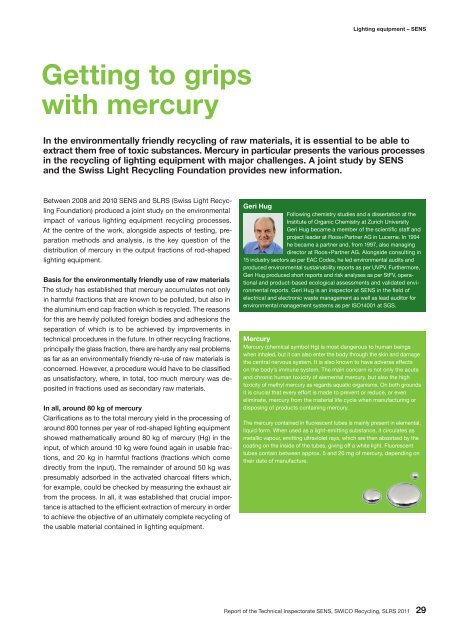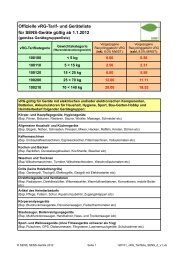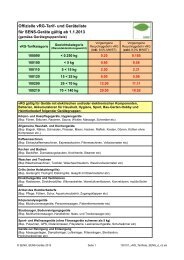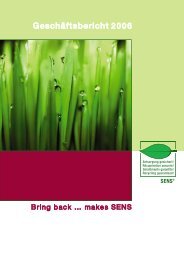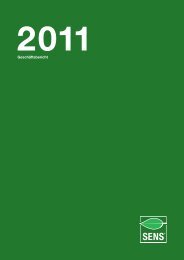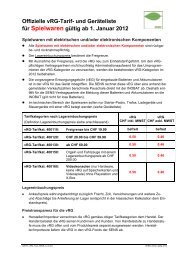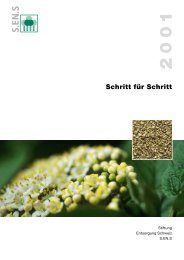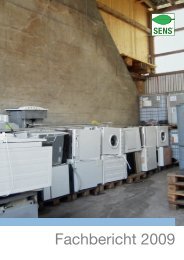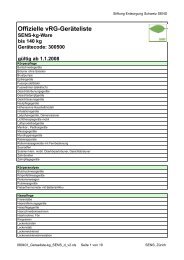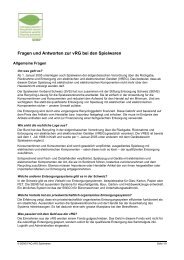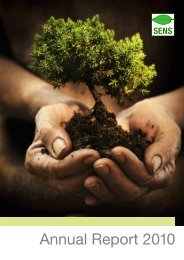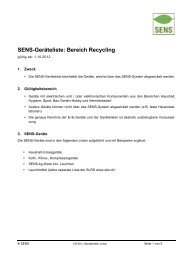Report of the Technical Inspectorate SENS, SWICO Recycling, SLRS
Report of the Technical Inspectorate SENS, SWICO Recycling, SLRS
Report of the Technical Inspectorate SENS, SWICO Recycling, SLRS
Create successful ePaper yourself
Turn your PDF publications into a flip-book with our unique Google optimized e-Paper software.
Getting to grips<br />
with mercury<br />
Lighting equipment – <strong>SENS</strong><br />
In <strong>the</strong> environmentally friendly recycling <strong>of</strong> raw materials, it is essential to be able to<br />
extract <strong>the</strong>m free <strong>of</strong> toxic substances. Mercury in particular presents <strong>the</strong> various processes<br />
in <strong>the</strong> recycling <strong>of</strong> lighting equipment with major challenges. A joint study by <strong>SENS</strong><br />
and <strong>the</strong> Swiss Light <strong>Recycling</strong> Foundation provides new information.<br />
Between 2008 and 2010 <strong>SENS</strong> and <strong>SLRS</strong> (Swiss Light <strong>Recycling</strong><br />
Foundation) produced a joint study on <strong>the</strong> environmental<br />
impact <strong>of</strong> various lighting equipment recycling processes.<br />
At <strong>the</strong> centre <strong>of</strong> <strong>the</strong> work, alongside aspects <strong>of</strong> testing, preparation<br />
methods and analysis, is <strong>the</strong> key question <strong>of</strong> <strong>the</strong><br />
distri bution <strong>of</strong> mercury in <strong>the</strong> output fractions <strong>of</strong> rod-shaped<br />
lighting equipment.<br />
Basis for <strong>the</strong> environmentally friendly use <strong>of</strong> raw materials<br />
The study has established that mercury accumulates not only<br />
in harmful fractions that are known to be polluted, but also in<br />
<strong>the</strong> aluminium end cap fraction which is recycled. The reasons<br />
for this are heavily polluted foreign bodies and adhesions <strong>the</strong><br />
separation <strong>of</strong> which is to be achieved by improvements in<br />
technical procedures in <strong>the</strong> future. In o<strong>the</strong>r recycling fractions,<br />
principally <strong>the</strong> glass fraction, <strong>the</strong>re are hardly any real problems<br />
as far as an environmentally friendly re-use <strong>of</strong> raw materials is<br />
concerned. However, a procedure would have to be classified<br />
as unsatisfactory, where, in total, too much mercury was deposited<br />
in fractions used as secondary raw materials.<br />
In all, around 80 kg <strong>of</strong> mercury<br />
Clarifications as to <strong>the</strong> total mercury yield in <strong>the</strong> processing <strong>of</strong><br />
around 800 tonnes per year <strong>of</strong> rod-shaped lighting equipment<br />
showed ma<strong>the</strong>matically around 80 kg <strong>of</strong> mercury (Hg) in <strong>the</strong><br />
input, <strong>of</strong> which around 10 kg were found again in usable fractions,<br />
and 20 kg in harmful fractions (fractions which come<br />
directly from <strong>the</strong> input). The remainder <strong>of</strong> around 50 kg was<br />
presumably adsorbed in <strong>the</strong> activated charcoal filters which,<br />
for example, could be checked by measuring <strong>the</strong> exhaust air<br />
from <strong>the</strong> process. In all, it was established that crucial importance<br />
is attached to <strong>the</strong> efficient extraction <strong>of</strong> mercury in order<br />
to achieve <strong>the</strong> objective <strong>of</strong> an ultimately complete recycling <strong>of</strong><br />
<strong>the</strong> usable material contained in lighting equipment.<br />
Geri Hug<br />
Following chemistry studies and a dissertation at <strong>the</strong><br />
Institute <strong>of</strong> Organic Chemistry at Zurich University<br />
Geri Hug became a member <strong>of</strong> <strong>the</strong> scientific staff and<br />
project leader at Roos+Partner AG in Lucerne. In 1994<br />
he became a partner and, from 1997, also managing<br />
director at Roos+Partner AG. Alongside consulting in<br />
15 industry sectors as per EAC Codes, he led environmental audits and<br />
produced environmental sustainability reports as per UVPV. Fur<strong>the</strong>rmore,<br />
Geri Hug produced short reports and risk analyses as per StFV, operational<br />
and product-based ecological assessments and validated environmental<br />
reports. Geri Hug is an inspector at <strong>SENS</strong> in <strong>the</strong> field <strong>of</strong><br />
electrical and electronic waste management as well as lead auditor for<br />
environmental management systems as per ISO14001 at SGS.<br />
Mercury<br />
Mercury (chemical symbol Hg) is most dangerous to human beings<br />
when inhaled, but it can also enter <strong>the</strong> body through <strong>the</strong> skin and damage<br />
<strong>the</strong> central nervous system. It is also known to have adverse effects<br />
on <strong>the</strong> body’s immune system. The main concern is not only <strong>the</strong> acute<br />
and chronic human toxicity <strong>of</strong> elemental mercury, but also <strong>the</strong> high<br />
toxicity <strong>of</strong> methyl mercury as regards aquatic organisms. On both grounds<br />
it is crucial that every effort is made to prevent or reduce, or even<br />
eliminate, mercury from <strong>the</strong> material life cycle when manufacturing or<br />
disposing <strong>of</strong> products containing mercury.<br />
The mercury contained in fluorescent tubes is mainly present in elemental,<br />
liquid form. When used as a light-emitting substance, it circulates as<br />
metallic vapour, emitting ultraviolet rays, which are <strong>the</strong>n absorbed by <strong>the</strong><br />
coating on <strong>the</strong> inside <strong>of</strong> <strong>the</strong> tubes, giving <strong>of</strong>f a white light. Fluorescent<br />
tubes contain between approx. 5 and 20 mg <strong>of</strong> mercury, depending on<br />
<strong>the</strong>ir date <strong>of</strong> manufacture.<br />
<strong>Report</strong> <strong>of</strong> <strong>the</strong> <strong>Technical</strong> <strong>Inspectorate</strong> <strong>SENS</strong>, <strong>SWICO</strong> <strong>Recycling</strong>, <strong>SLRS</strong> 2011 29


